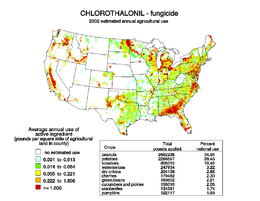- Chlorothalonil
-
Chlorothalonil  2,4,5,6-tetrachloroisophthalonitrileOther namesBravo
2,4,5,6-tetrachloroisophthalonitrileOther namesBravo
Daconil
tetrachloroisophthalonitrileIdentifiers CAS number 1897-45-6 
ChemSpider 13861400 
UNII J718M71A7A 
KEGG C11037 
ChEBI CHEBI:3639 
ChEMBL CHEMBL468167 
RTECS number NT2600000 Jmol-3D images Image 1 - Clc1c(C#N)c(Cl)c(C#N)c(Cl)c1Cl
Properties Molecular formula C8Cl4N2 Molar mass 265.91 g mol−1 Appearance white crystalline solid Density 1.8 g cm−3, solid Melting point 250 °C
Boiling point 350 °C (760 mmHg)
Solubility in water 0.06 g/100 ml log P 2.88-3.86 Related compounds Related organochlorides hexachlorobenzene
dichlorobenzene
chlorobenzene (verify) (what is:
(verify) (what is:  /
/ ?)
?)
Except where noted otherwise, data are given for materials in their standard state (at 25 °C, 100 kPa)Infobox references Chlorothalonil (2,4,5,6-tetrachloroisophthalonitrile) is a polychlorinated aromatic mainly used as a broad spectrum, non-systemic fungicide, with other uses as a wood protectant, pesticide, acaricide, and to control mold, mildew, bacteria, algae.[1] Chlorothalonil-containing products are sold under the names Bravo, Echo, and Daconil. It was first registered for use in the US in 1966. In 1997, the most recent year for which data is available, it was the third most used fungicide in the US, behind only sulfur and copper, with some 12 million lbs used in agricultural alone that year.[2] Including non-agricultural uses, the EPA estimates that on average almost 15 million lbs were used in annually from 1990-1996.[1]
Contents
Uses
In the US, chlorothalonil is used predominantly on peanuts (about 34% of US usage), potatoes (about 12%), and tomatoes (about 7%), though the EPA recognizes its use on many other crops.[1] It is also used on golf courses and lawns (about 10%) and as a preservative additive in some paints (about 13%), resins, emulsions, and coatings.[1]
Chlorothalonil is commercially available in many different formulations and delivery methods. It is applied as a dust, dry or water-soluble grains, a wettable powder, a liquid spray, a fog, and a dip. It may be applied by hand, by ground sprayer, or by aircraft.[1]
Mechanism of action
Chlorothalonil reduces fungal intracellular glutathione molecules to alternate forms which cannot participate in essential enzymatic reactions, ultimately leading to cell death, similar to the mechanism of trichloromethyl sulfenyl.[3]
Toxicity
Acute
According to the United States Environmental Protection Agency, chlorothalonil is a Toxicity Category I eye irritant, producing severe eye irritation. It is in Toxicity Category II, "moderately toxic," if inhaled (inhaled LD50 0.094 mg/L in rats.) For skin contact and ingestion, chlorothalonil is rated Toxicity Category IV, "practically non-toxic," meaning the oral and dermal LD50 is greater than 10,000 mg/kg.[1]
Chronic
Long term exposure to chlorothalonil resulted in kidney damage and tumors in animal tests.[1]
Carcinogenic
Chlorothalonil is a Group B2 "probable human carcinogen", based on observations of cancers and tumors of the kidneys and forestomach in laboratory animals fed diets containing chlorothalonil.[1] ticides.
Environmental
Chlorothalonil is highly toxic to fish and aquatic invertebrates, but not toxic to birds.[4]
Chlorothalonil has been suggested as a partial cause of Colony Collapse Disorder, among many other factors.[5]
At a concentration of 164µg/L, chlorothalonil was found to kill test a species of frog within a 24h exposure.[6]
Contaminants
Common chlorothalonil synthesis procedures frequently result in chlorothalonil contaminated with small amounts of hexachlorobenzene, which is itself toxic. US regulations limit HCB in commercial production to 0.05% of chlorothalonil. According to the EPA report, "post-application exposure to HCB from chlorothalonil is not expected to be a concern based on the low level of HCB in chlorothalonil."[1]
Environmental contamination
Chlorothalonil has been detected in ambient air in Minnesota[7] and Prince Edward Island,[8] as well as in groundwater in Long Island, New York[1] and Florida.[1] In the first three cases, the contamination is presumed to have come from potato farms.
The main breakdown product of chlorothalonil is SDS-3701 (4-hydroxy-2,5,6-trichloroisophthalonitrile). It has been shown to be 30 times more acutley toxic than chlorothalonil and more persistent in the environment.[9] Laboratory experiments have shown that it can thin the eggshells of birds, but there is no evidence that this is happening in the environment.[1]
Chemistry
Chlorothalonil can by produced by the direct chlorination of isophthalonitrile or by treating tetrachloroisophthaloyl amide with phosphoryl chloride. It breaks down under basic conditions but is stable in neutral and acidic media.[4] Technical chlorothalonil contains traces of dioxins and hexachlorobenzene,[1] a persistent organic pollutant banned under the Stockholm Convention.
References
- ^ a b c d e f g h i j k l m Reregistration Eligibility Decision for chlorothalonil, US EPA, 1999.
- ^ PESTICIDE USE IN U.S. CROP PRODUCTION: 1997 National Center for Food and Agricultural Policy, 1997.
- ^ Tillman, Ronald; Siegel, Malcom; Long, John (June, 1973), "Mechanism of action and fate of the fungicide chlorothalonil (2,4,5,6-tetrachloroisophthalonitrile) in biological systems : I. Reactions with cells and subcellular components of Saccharomyces pastorianus", Pesticide Biochemistry and Physiology 3 (2): 160–167, doi:10.1016/0048-3575(73)90100-4
- ^ a b Environmental Health Criteria 183, World Health Organization, 1996.
- ^ [1], Scientific American
- ^ Taegan McMahon, Neal Halstead, Steve Johnson, Thomas R. Raffel, John M. Romansic, Patrick W. Crumrine, Raoul K. Boughton, Lynn B. Martin, Jason R. Rohr "The Fungicide Chlorothalonil is Nonlinearly Associated with Corticosterone Levels, Immunity, and Mortality in Amphibians" Environ Health Perspectives, 2011, Online: 04 April. doi:10.1289/ehp.1002956
- ^ Pesticides and Air Pollution in Minnesota: The Frequency of Detection of Chlorothalonil, a Fungicide Used on Potatoes. Pesticide Action Network North America, Oct 2007.
- ^ White, Louise M; et al., WR; Julien, G; Garron, C; Leger, M (2006), "Ambient air concentrations of pesticides used in potato cultivation in Prince Edward Island, Canada.", Pest Manag Sci 62 (2): 126–136, doi:10.1002/ps.1130, PMID 16358323, http://www3.interscience.wiley.com/cgi-bin/abstract/112168257/ABSTRACT
- ^ Cox, Caroline (1997), "Fungicide Factsheet: Chlorothalonil", Journal of Pesticide Reform 17 (4): 14–20, http://www.pesticide.org/get-the-facts/pesticide-factsheets/factsheets/chlorothalonil
External links
Categories:- Fungicides
- Nitriles
- Organochlorides
- IARC Group 2B carcinogens
Wikimedia Foundation. 2010.

